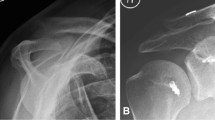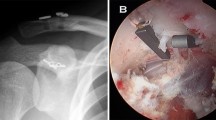Abstract
Purpose and hypothesis
Due to high rate of persisting dynamic posterior translation (DPT) following isolated coracoclavicular double-button technique for reconstruction of the acromioclavicular (AC) joint reported in the literature, an additional acromioclavicular cerclage was added to the procedure. The aim of this study was to evaluate the clinical and radiological results of patients with high-grade AC-joint instability treated with a double TightRope technique with an additional percutaneous acromioclavicular cerclage.
Methods
Fifty-nine patients (6 f/53 m; median age 38.3 (range 21.5–63.4 years) who sustained an acute high-grade AC-joint dislocation (Rockwood type V) were treated using the above-mentioned technique. At the final follow-up, the constant score (CS), the subjective shoulder value (SSV), the Taft score (TF) and the acromioclavicular joint instability score (ACJI) as well as bilateral anteroposterior stress views with 10 kg of axial load and bilateral modified Alexander views were obtained.
Results
At a median follow-up of 26.4 (range 20.3–61.0) months, 34 patients scored a median of 90 (33–100) points in the CS, 90 (25–100) % in the SSV, 11 (4–12) points in the TF and 87 (43–100) points in the ACJI. The coracoclavicular (CC) distance was 12.1 (6.5–19.8) mm and the CC difference 2.0 (0.0–11.0) mm. Two patients (5.8%) showed a complete DPT of the AC joint, and fourteen patients (41.1%) displayed a partial DPT. The overall revision rate was 11.7%. Two patients presented implant irritation, one patient a recurrent instability, and one patient suffered from a local infection.
Conclusion
The arthroscopically assisted and image-intensifier-controlled double TightRope technique with an additional percutaneous acromioclavicular cerclage leads to good and excellent clinical results after a follow-up of 2 years. The incidence of persisting dynamic horizontal translation is lower compared to isolated coracoclavicular stabilization. Thus, we recommend using the double TightRope implant with an additional acromioclavicular cerclage.
Level of evidence
IV.





Similar content being viewed by others
References
Alexander OM (1954) Radiography of the acromioclavicular articulation. Med Radiogr 30(2):34–39
Balke M (2016) Diagnosis and treatment of acute acromioclavicular joint injuries. Arch Trauma Res. doi:10.5812/atr.40081
Balke M, Schneider MM, Shafizadeh S, Baethis H, Bouillon B, Banerjee M (2013) Current state of treatment of acute acromioclavicular joint. Knee Surg Sports Traumatol Arthrosc 23(5):1447–1452
Chillemi C, Franceschini V, Dei Giudici L, Alibardi A, Salate Santone F, Ramos Alday LJ, Osimani M (2013) Epidemiology of isolated acromioclavicular joint dislocation. Emerg Med Int. doi:10.1155/2013/171609
Constant CR, Murley AH (1987) A clinical method of functional assesment of the shoulder. Clin Orthop Relat Res 214:160–164
Elser F, Chernchujit B, Ansah P, Imhoff AB (2005) A new minimally invasive arthroscopic technique for reconstruction of the acromioclavicular joint. Unfallchirurg 108(8):645–649
Faul F, Erdfelder E, Buchner A, Lang AG (2009) Statistical power analyses using G*Power 3.1: tests for correlation and regression analyses. Behav Res Methods 41:1149–1160
Fuchs B, Jost B, Gerber C (2000) Posterior-inferior capsular shift for the treatment of recurrent, voluntary posterior subluxation of the shoulder. J Bone Joint Surg Am 82(1):16–25
Gerhardt C, Kraus N, Greiner S, Scheibel M (2011) Arthroskopische Stabilisierung der akuten Schultereckgelenksprengung. Orthopäde 40:61–69
Greiner S, Braunsdorf J, Perka C, Herrmann S, Scheffler S (2009) Mid to long-term results of open acromioclavicular-joint reconstruction using polydioxansulfate cerclage augmentation. Arch Orthop Trauma Surg 129(6):735–740
Habernek H, Weinstabl R, Schmid L, Fialka C (1993) A crook plate for treatment of acromioclavicular joint separation: indication, technique, and results after one year. J Trauma 35(6):893–901
Jensen G, Karthagern JC, Alvarado LE et al (2014) Has the arthroscopically assisted reduction of acute AC joint separations with the double tight-rope technique advantages over the clavicular hook plate fixation? Knee Surg Sports Traumatol Arthrosc 22(2):422–430
Kraus N, Hass NP, Scheibel M, Gerhardt C (2013) Arthroscopically assisted stabilization of acute high-grade acromioclavicular joint separations in a coracoclavicular Double-TightRope technique: V-shaped versus parallel drill hole orientation. Arch Orthop Trauma Surg 133(10):1431–1440
Kraus N, Minkus M, Scheibel M (2015) Schultereckgelenksprengungen Wann und wie sollten sie behandelt werden? Trauma Berufskrankh. doi:10.1007/s10039-014-2147-6
Kraus N, Scheibel M (2011) Arthroskopisch-assistierterte Stabilisierung der akuten Schultereckgelenksinstabilität. Obere Extremität 6(2):90–98
Kraus N, Scheibel M (2014) Verletzungen des Schultereckgelenks bei Sportlern. Chirurg 85(10):854–863
Lim YW, Sood A, van Riet RP, Bain GI (2007) Acromioclavicular joint reduction, repair and reconstruction using metallic buttons—early results and complications. Tech Shoulder Elbow Surg 8(4):213–221
Lizaur A, Marco L, Cebrian R (1994) Acute dislocation of the acromioclavicular joint. Traumatic anatomy and the importance of deltoid and trapezius. J Bone Joint Surg Br 76(4):602–606
Minkus M, Hann C, Scheibel M, Kraus N (2017) Quantification of dynamic posterior translation in modified. Arch Orthop Trauma Surg 137(6):845–852
Nordqvist A, Petersson CJ (1995) Incidence and causes of shoulder girdle injuries in an urban population. J Shoulder Elbow Surg 4(2):107–112
Nuechtern JV, Sellenschloh K, Bishop N, Jauch S, Briem D, Hoffmann M, Lehmann W, Pueschel K, Morlock MM, Rueger JM, Großterlinden LG (2013) Biomechanical evaluation of 3 stabilization methods on acromioclavicular joint dislocations. Am J Sports Med 41(6):1387–1394
Rockwood C (1984) Injuries in the acromioclavicular joint: subluxations and dislocations about the shoulder. In: Rockwood CA Jr, Green DP (eds) Fracture in adults. J B Lippincott, Philadelphia, pp 860–910
Rolla PR, Surace MF, Murena L (2004) Arthroscopic treatment of acute acromioclavicular joint dislocation. Arthroscopy 20(6):662–668
Saier T, Venjakob AJ, Minzlaff P, Föhr P, Lindell F, Imhoff AB, Vogt S, Braun S (2015) Value of additional acromioclavicular cerclage for horizontal stability in complete acromioclavicular separation: a biomechanical study. Knee Surg Sports Traumatol Arthrosc 23(5):1498–1505
Salem KH, Schmelz A (2009) Treatment of Tossy III acromioclavicular joint injuries using hook plates and ligament suture. J Orthop Trauma 23(8):565–569
Salzmann GM, Walz L, Buchmann S, Glabgly P, Venjakob A, Imhoff AB (2010) Arthroscopically assisted 2-bundle anatomical reduction of acute acromioclavicular joint separations. Am J Sports Med 38(6):1179–1187
Salzmann GM, Walz L, Schoettle PB, Imhoff AB (2008) Arthroscopic anatomical reconstruction of the acromioclavicular joint. Acta Orthop Belg 74(3):397–400
Scheibel M, Dröschel S, Gerhardt C, Kraus N (2011) Arthroscopically assisted stabilization of acute high-grade acromioclavicular joint separations. Am J Sports Med 39(7):1507–1516
Taft TN, Wilson F (1987) Dislocation of the acromioclavicular joint. An end-result study. J Bone Joint Surg Am 69(7):1045–1051
Walz L, Salzmann GM, Fabbro T, Eichhorn S, Imhoff AB (2008) The anatomic reconstruction of acromioclavicular joint dislocations using 2 TightRope devices: a biomechanical study. Am J Sports Med 36(12):2398–2406
Wellmann M, Smith T, Windhagen H, Siebert CH (2011) Biomechanik aktueller Rekonstruktionstechniken bei Schultereckgelenksprengungen. Obere Extremität 6(2):85–89
Wolf EM, Pennington WT (2001) Arthroscopic reconstruction for acromioclavicular joint dislocation. Arthroscopy 17(5):558–563
Woodmass JM, Esposito JG, Ono Y, Nelson AA, Boorman RS, Thornton GM, Lo IK (2015) Complications following arthroscopic fixation: a systematic review of the literature. Open Access J Sports Med 6:97–107. doi:10.2147/OAJSM.S73211
Acknowledgements
The authors would like to state that no outside funding or grants were received that assisted in the above-mentioned study. Carmen Hann, Natascha Kraus, Marvin Minkus and Nina Maziak, their immediate family, and any research foundation with which they are affiliated have not received any financial payments or other benefits from any commercial entity related to the subject of this article. Markus Scheibel received consultant payments from Arthrex Company related to this work. This study was approved by the Local Ethical Committee (EA1/298/12).
Author information
Authors and Affiliations
Corresponding author
Ethics declarations
Conflict of interest
Carmen Hann, Natascha Kraus, Marvin Minkus and Nina Maziak declare that they have no conflict of interest. Markus Scheibel is consultant for Arthrex.
Funding
No external source of funding was used.
Ethical approval
The local ethical committee of the Charité Universitaetsmedizin Berlin approved the study protocol (EA1/298/12).
Informed consent
Patients gave written informed consent.
Rights and permissions
About this article
Cite this article
Hann, C., Kraus, N., Minkus, M. et al. Combined arthroscopically assisted coraco- and acromioclavicular stabilization of acute high-grade acromioclavicular joint separations. Knee Surg Sports Traumatol Arthrosc 26, 212–220 (2018). https://doi.org/10.1007/s00167-017-4643-2
Received:
Accepted:
Published:
Issue Date:
DOI: https://doi.org/10.1007/s00167-017-4643-2




